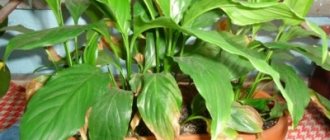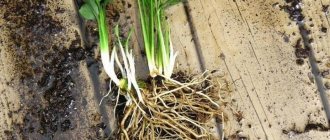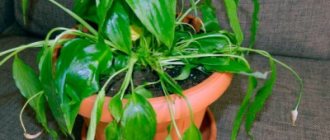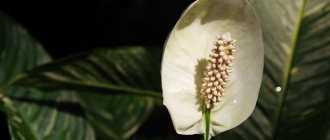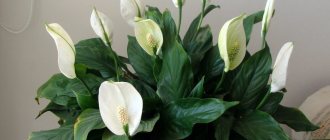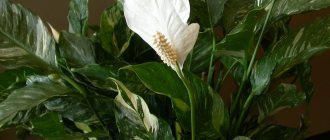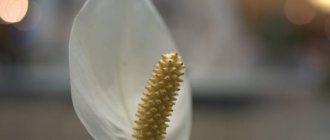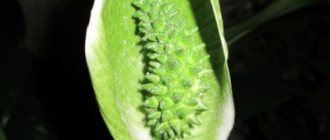Why does the foliage of the “female happiness” flower turn pale?
Sometimes spathiphyllum foliage begins to lighten. Several reasons can lead to this.
Errors in care
- Dry air . If the crop is kept in a room with dry air, a small area of the leaf will turn pale first (only 1-2 mm). But if the cause is not eliminated, the light spots will turn black and begin to grow.
- Sunburns . If the plant is placed on the sunny side of the room, the foliage may get burned. In this case, the plates first become pale green and then turn yellow. Leaves look emaciated.
- Lack of nutrients . With a lack of nutrients, pale spots appear chaotically, the foliage resembles a mosaic. Sometimes only the veins lighten up, or vice versa, only they remain green. Often such changes signal a deficiency of boron, calcium or iron. This usually happens during the flowering period.
- Errors in watering . Moreover, both a lack of moisture and its excess can lead to the appearance of stains. But we note that excess water in the soil is more dangerous, as it leads to rotting of the root system.
- Decrease in air temperature . Spathiphyllum reacts sharply to temperature changes and drafts. If the plant is overcooled, the foliage turns pale at the edges. Gradually, light pigmentation spreads over the entire area of the leaves.
- Untimely transplant . Transplantation is necessary for the plant so that it receives all the nutrients on time and in full. If the root system of a crop has grown and is falling out of the flowerpot, it urgently needs to be replanted. In the absence of transplantation, the roots simply have nowhere to take nutrients, which is why all parts of the plant become lighter.
What diseases can cause such pallor?
The presence of diseases is signaled not only by the blanching of the leaf blades, but also by their damage on the underside.
Inspect the entire plate. With fungal and viral infections, a whitish coating, thin cobwebs or plaques appear on the back of the leaf.
Pests
Spathiphyllum is attacked by the following parasitic insects:
- Thrips . Suck out all the juices from the leaves. Additional signs are the appearance of brown dots on the foliage and a silvery coating on it. Young leaves become smaller and deformed.
- Mealybug . In addition to pale spots, a sticky coating appears on the foliage (on the reverse side). The scale insect can also be seen during a visual inspection of the plant (the length of one parasite is 8-10 mm).
- Spider mite . The pest is very small, so it can only be recognized by light spots on the leaves and the appearance of cobwebs.
- Shield . Located on the underside of the foliage. The leaves first turn pale and then curl.
Flower of female happiness - leaves turn yellow, what to do, how to save spathiphyllum
Spathiphyllum is popularly called “female happiness.” This evergreen tropical plant has amazing beauty. In the wild, it grows along the shores of reservoirs in South America and New Guinea.
The article will introduce you to the amazing spathiphyllum plant, the rules of care and propagation, and give some useful tips.
Description of the plant
This indoor plant can be easily identified among the other inhabitants of the winter garden. It has no stem, the leaves grow directly from the ground and are richly green in color. The midrib is clearly visible on the leaf blade.
The flower is a yellowish-white spadix, surrounded by a snow-white leaf, in the form of a drop, located on a high peduncle. The white bedspread is sometimes decorated with greenish inclusions. During flowering, it acquires a uniform green color.
Popular varieties
Spathiphyllum is not only an ornamental plant, but also useful:
- is capable of purifying the room air from the presence of toxic substances in it, such as carbon monoxide, xylene, formaldehyde, trichlorethylene, benzene
- increases air humidity, releasing substances into it that prevent the development of mold fungi.
Almost fifty varieties of Women's Happiness are known to flower growers today, of which the most common ones are found on window sills and in winter gardens:
profusely blooming
It is a low bush. It has cream flowers with a pleasant delicate aroma. The spathe is much larger than the cob. It begins to bloom in March and ends in October. It was this feature that gave rise to this name.
It is smaller in size compared to the Abundantly flowering representative of this family. The flowers have narrow, elongated, pointed veils.
Cannofolia
The snowy blanket of the flower envelops the yellow-green spadix. The leaves are large, their color is rich, reminiscent of cannas. Has a pronounced aroma.
Charming
The plant has large, elongated leaves. The greenish-white blanket resembles a flag. Which was the reason for the second name “flagolite”. Blooms profusely.
Heliconifolia
Representatives of this species reach a height of up to one hundred centimeters. Their platinum sheets have wavy edges, a glossy sheen, and are painted dark green. The cob is almost twice as small as the oval spathe.
The presented species were used as a basis for breeding hybrid species, including giants and dwarfs. Hybrid varieties are hardy, bloom for a long time and profusely.
Rules of care
When buying a flower in a store that specializes in selling indoor flowers, it needs to be replanted, and for this you need:
- prepare the soil thoroughly
- the soil mixture should consist of peat, sand, leaf soil and manure humus, taken in equal proportions. The mixture also necessarily contains ceramic chips and crushed birch charcoal.
- The diameter of the pot should exceed the previous one by a couple of centimeters. It must be remembered that the flower needs to be replanted once a year. The pot needs to be enlarged with each transplant.
- the hole intended for removing excess liquid must be covered with a shard with a bulge, and pebbles or expanded clay balls should be poured on top,
To propagate Women's Happiness, the bush can be divided into parts during transplantation. Soaking the earthen ball will help simplify this procedure. The root collar cannot be buried, because the spathiphyllum will stop blooming. The size of the pot should be such that it is a little cramped for the roots. After planting the sprout, compact the substrate and water thoroughly.
If the edges of the leaves dry out slightly, this is not a problem, because the flower needs adaptation.
Women's happiness prefers northern windows, but in winter they can also be placed on the windowsills of southern windows. We must not forget that exposure to direct rays of the sun can cause burns to the flower and cause disease in the root system.
The main condition for maintaining the decorative appearance of the plant is bathing. It loves showers. Its foliage needs to be irrigated with a spray bottle. He really likes to be in the shade, warm, but not stuffy. In summer, the flower will have a comfortable temperature of +22-24 degrees, and in winter – no lower than +17 degrees.
Women's happiness prefers moisture, but its excess can cause rotting of the root system. Experienced gardeners usually wait until the plant itself asks for water: by lowering its leaves. Such a period of drought is not harmful to him. When winter comes, watering is done less frequently, shower procedures are not carried out, only occasionally sprayed.
The plant needs regular feeding.
They need to be carried out when it grows green mass and blooms. Liquid fertilizers are perfect for this; they are diluted in the dose indicated on the package and watered into a pre-moistened soil ball. Fertilizer during the winter period of Women's Happiness does not need to be done as often as in the summer. Just once for the entire period will be enough.
Spathiphyllums are afraid of drafts.
It is necessary to place pots with these flowers away from doors and windows. To increase the duration of flowering, old flower stalks need to be cut off close to the ground. This will make it possible to release new arrows. Simple but mandatory care will extend the flowering period.
Spathiphyllum diseases
The leaves are turning yellow
What to do when the leaves of Women's Happiness change their usual color to yellow? The reason for this is non-compliance with the watering regime: either the flower was not watered for a long time, or water was poured too often. For treatment, you need to streamline watering.
Another reason for yellowing foliage is the plant’s need for vitamins and minerals. This flower usually suffers from a lack of magnesium. Feeding him with magnesium sulfate will help.
Leaves turn black
A similar phenomenon occurs when there is insufficient or excess fertilizer, when there is low air humidity in the room where the plant is located, or when watering the plant with the wrong water.
To prevent such manifestations you need:
- fertilize the plant every ten days from spring to autumn, and only once in winter,
- water only with soft, settled water,
- remember about water procedures - water the flower weekly from the shower,
- choose a good place for spathiphyllum.
Flowers turn yellow or black
When such a sign appears, you need to treat the soil with foundationazole dissolved in water. Dissolve two drops of the drug in a liter of water and water the plant.
Leaves are drying
When the leaves of the Flower of Women's Happiness begin to dry, it means that the humidity in the room where it is located is too low. Dry air is the main reason why plant leaves begin to dry out.
Spathiphyllums are often attacked by thrips, spider mites, and mealybugs. Using a regular soap solution will help get rid of harmful insects.
You just need to wash the foliage with the prepared solution. If the case of pest infestation has already started, then you need to use special chemicals that can be bought at a flower shop.
If the above methods did not help the flower of Women's Happiness, and it continues to die, you can try to revive it in such a way as transplantation. Remove the plant from the pot. Soak the earthen ball and free the roots from the soil. Divide the bush into parts, if possible, and place each of them in an opaque container with water.
Plants should be kept in water until new roots begin to grow. After which they can be planted in a new substrate.
Signs associated with the flower Women's happiness
This flower is called Women's Happiness for a reason. It is believed that this indoor plant can bring good luck and family well-being to its owner. You cannot give your personal spathiphyllum to anyone, because in this way you will transfer your happiness into the wrong hands.
There is a sign that a wish will begin to come true when the bud opens. If the plant dries out, it is bad and is compared to the loss of happiness.
In a house in which there is spathiphyllum, it is strictly forbidden to quarrel and create scandals. He feels negative energy and this causes him stress, which can lead to his death.
If you handle the plant carefully, you can ask it to grant your wish. In gratitude for the love and affection, the plant will fulfill the request. Women's happiness can be bought independently or received as a gift. You need to buy on Wednesday, Friday, Saturday - the so-called women's days. You can only donate shoots.
And a flower, specially purchased for gifting, can help any woman fulfill her wishes. For example, an unmarried woman will find her love, a childless woman will become pregnant and give birth to a healthy child.
Growing spathiphyllum at home is not difficult. To do this, you need to properly care for it. Be loving and caring towards him, and he will respond in kind.
What to do if the leaves become lighter?
To save “women’s happiness,” the florist must perform the following steps::
- Normalize watering. The soil is moistened only after 1/3 of the total volume of soil has dried out. And at the same time do not allow the soil to dry out. For irrigation, take settled water at room temperature.
- Spray the crop daily to maintain optimal air humidity levels.
- The air temperature in summer and spring should be 25-27 degrees, and in autumn and winter – 15-18 degrees.
- During the period of active plant growth, feed it regularly (once a week), using ready-made mineral complexes for this.
- To combat diseases, treat spathiphyllum with a fungicide, and use insecticides to kill pests.
Prevention
Preventive measures consist of the simplest measures:
- Humidity level maintenance.
- Position the plant in such a way that it receives only diffuse sunlight.
- Regular watering and fertilizing (without exceeding the recommended dosage).
- When parasites or diseases appear, the crop is treated with special means and transplanted into new soil and a flowerpot.
Failure to follow the rules of care can lead to problems with growing “female happiness” and loss of its decorative value. The florist should respond to changes quickly and competently.
Source
What causes spathiphyllum leaves to curl?
Leaf blades begin to curl and new ones begin to shrink when changes in care regime are necessary: watering, lighting or nutrition. Sources of the problem include:
- reduced room temperature. The leaves acquire dark shades, even burgundy-green. They begin to wrap themselves in peculiar cocoons. The deviation is caused by being in a place where there are constant drafts, or air from the air conditioner hits the plant;
Spathiphyllum leaves curl
- lack of lighting. The problem is relevant in the winter months or during prolonged and prolonged rains. To correct the situation, use a specialized ultraviolet lamp; it will help compensate for the lack of sunlight;
- aphid damage. The attack of the parasitic insect is suppressed by insecticides. Experienced flower growers prefer to use Actellik, which gives the desired effect after the first procedure.
For your information! Some varieties of spathiphyllum have an innate predisposition to folding leaf plates. This process has the opposite effect - after some time they unfold independently, without outside help.
Why does the foliage of the “female happiness” flower turn pale?
Sometimes spathiphyllum foliage begins to lighten. Several reasons can lead to this.
Errors in care
- Dry air. If the crop is kept in a room with dry air, a small area of the leaf will turn pale first (only 1-2 mm). But if the cause is not eliminated, the light spots will turn black and begin to grow.
- Sunburns. If the plant is on the sunny side of the room, the foliage may get burned. In this case, the plates first become pale green and then turn yellow. Leaves look emaciated.
- Lack of nutrients. With a lack of nutrients, pale spots appear chaotically, the foliage resembles a mosaic. Sometimes only the veins lighten up, or vice versa, only they remain green. Often such changes signal a deficiency of boron, calcium or iron. This usually happens during the flowering period.
- Errors in watering. Moreover, both a lack of moisture and its excess can lead to the appearance of stains. But we note that excess water in the soil is more dangerous, as it leads to rotting of the root system.
- Decrease in air temperature. Spathiphyllum reacts sharply to temperature changes and drafts. If the plant is overcooled, the foliage turns pale at the edges. Gradually, light pigmentation spreads over the entire area of the leaves.
- Untimely transplant. Transplantation is necessary for the plant so that it receives all the nutrients on time and in full. If the root system of a crop has grown and is falling out of the flowerpot, it urgently needs to be replanted. In the absence of transplantation, the roots simply have nowhere to take nutrients, which is why all parts of the plant become lighter.
What diseases can cause such pallor?
The presence of diseases is signaled not only by the blanching of the leaf blades, but also by their damage on the underside.
Inspect the entire plate. With fungal and viral infections, a whitish coating, thin cobwebs or plaques appear on the back of the leaf.
Pests
Spathiphyllum is attacked by the following parasitic insects:
- Thrips. Suck out all the juices from the leaves. Additional signs are the appearance of brown dots on the foliage and a silvery coating on it. Young leaves become smaller and deformed.
- Mealybug. In addition to pale spots, a sticky coating appears on the foliage (on the reverse side). The scale insect can also be seen during a visual inspection of the plant (the length of one parasite is 8-10 mm).
- Spider mite. The pest is very small, so it can only be recognized by light spots on the leaves and the appearance of cobwebs.
- Shield. Located on the underside of the foliage. The leaves first turn pale and then curl.
Spathiphyllum: home care, why the tips of the leaves dry out
Why do aloe leaves turn yellow and leaf tips dry out?
There are several versions of this anomaly. Experts advise finding the source of the problem and immediately treating spathiphyllum. The list of possible factors includes:
- incorrect calculation of fertilizing. If the supply of minerals is insufficient, a similar picture can be observed: the foliage will gradually begin to dry out. For therapy, a nitrogen-potassium-phosphorus mixture is used;
- water scarcity. Initially, the leaf plates lighten and become yellow, and later begin to dry out. For a tropical plant living in a marine climate, dry air is very harmful. To compensate for insufficient moisture, the foliage should be regularly wiped with a cotton pad soaked in liquid and sprayed with a spray bottle. The tray can be filled with pebbles, sand and expanded clay and only then pour water into it and place it under the pot;
Leaves dry around the edges
- excessive humidity. It also causes the tips of spathiphyllum foliage to dry out. Excessive moisture, compacted soil and lack of drainage layer provoke stagnation of water. The root system begins to rot and the leaf blades dry out. To solve the problem, take a double container and line the space between the walls with damp peat or moss.
Note! Being in direct sunlight or in a cold room is also not suitable for spathiphyllum. If it stays in these conditions for a long time, it will begin to die. The only way to avoid tragedy is to move the flower to a more suitable place and protect it from sunlight.
What to do if the leaves become lighter?
To save “women’s happiness,” the gardener must perform the following steps:
- Normalize watering. The soil is moistened only after 1/3 of the total volume of soil has dried out. And at the same time do not allow the soil to dry out. For irrigation, take settled water at room temperature.
- Spray the crop daily to maintain optimal air humidity levels.
- The air temperature in summer and spring should be 25-27 degrees, and in autumn and winter – 15-18 degrees.
- During the period of active plant growth, feed it regularly (once a week), using ready-made mineral complexes for this.
- To combat diseases, treat spathiphyllum with a fungicide, and use insecticides to kill pests.
Prevention
Preventive measures consist of the simplest measures:
- Humidity level maintenance.
- Position the plant in such a way that it receives only diffuse sunlight.
- Regular watering and fertilizing (without exceeding the recommended dosage).
- When parasites or diseases appear, the crop is treated with special means and transplanted into new soil and a flowerpot.
Failure to follow the rules of care can lead to problems with growing “female happiness” and loss of its decorative value. The florist should respond to changes quickly and competently.
Source
Why leaves of spathiphyllums lighten: natural causes and errors in care
Spathiphyllum is an exquisite, decorative flower. Large white or soft beige bracts seem to protect bright inflorescences-cobs of all shades of yellow. They look especially expressive against the background of rich green leaves. Sometimes, due to errors in care or illness, a beautiful flower loses the brightness of its colors. If you understand why the leaves of spathiphyllum lighten, you can completely return the plant to its beauty.
Frequently Asked Questions: Spathiphyllum
Home / Frequently asked questions| General information on caring for spathiphyllum. |
- The tips of the leaves of my spathiphyllum are drying out, although I regularly spray the flower twice a day and, of course, water it. In addition, dry brownish-yellow spots have appeared on some leaves, similar to burns, although direct sunlight does not fall on the flower.
- The flowers of the spathiphyllum have begun to turn green.
- Spathiphyllum does not bloom.
- My spathiphyllum leaves turn black and dry at the edges, then die completely, sometimes young leaves that have not yet untwisted dry out.
- Spathiphyllum “Domino”, after 2 weeks the tips of the leaves began to dry out, one leaf turned yellow, now the “Blanket”, which has not yet blossomed, is drying up. It stands in a warm room, the light is moderate, I water and spray it regularly. Tell me what to do so that the flower does not disappear?
- How to water spathiphyllum?
- Spathiphyllum does not grow.
- Brown spots appeared on the leaves of the spathiphyllum (about 60 cm high), mainly along the edges.
- Spathiphyllum leaves dry out, despite frequent spraying.
1. The tips of the leaves of my spathiphyllum are drying out, although I regularly spray the flower twice a day and, of course, water it. In addition, dry brownish-yellow spots have appeared on some leaves, similar to burns, although direct sunlight does not fall on the flower.
Answer:
If these spots are on the tips of the leaves, then this is a sign of overwatering. Here's some trivial advice: water only when the soil dries out. The tips of the leaves will dry out slightly one way or another - still not a greenhouse. If your spathiphyllum was purchased recently, don’t worry. The new leaves will be more resilient. By the way, spathiphyllum really loves a weekly shower (not spraying, but bathing). When spots are in the center of the leaf, there may be a mite, check for parasites.
2. The flowers of the spathiphyllum began to turn green.
Answer:
The covers of the flowers turn green - the flower actually fades and the peduncle itself can be cut off, but there is no need to cut off the entire plant. In addition, the literature says that depending on the varieties of spathiphyllum, the color of the flower cover can be from light green to cream. And on Galina’s website I found that there is such a variety of spathiphyllum “S. pleasant - S. blandum Schott... with... pale green spathe throughout the flowering period.”
3. Spathiphyllum does not bloom.
Answer:
Spathiphyllum blooms when the roots fill the entire pot. That is, he loves cramped and low pots. And one more opinion: “I just read: in order to achieve abundant flowering, spathiphyllum must be kept in the cold for 2 weeks at a temperature of +9 * + 12 * C. (Elenium)”
4. My spathiphyllum leaves turn black at the edges and dry out, then die completely, sometimes young leaves that have not yet untwisted dry out.
Answer:
Either you flood the plant, or you don’t add dry air, or it lacks nitrogen or phosphorus. In the latter case, feed with nitrogen-potassium-phosphorus fertilizer. I had this happen due to overwatering. It was the ends that turned black, not dried out.
5. Spathiphyllum “Domino”, after 2 weeks the tips of the leaves began to dry out, one leaf turned yellow, now the “Blanket”, which has not yet blossomed, is drying up. It stands in a warm room, the light is moderate, I water and spray it regularly. Tell me what to do so that the flower does not disappear?
Answer:
If you gave it in winter, it might freeze. If you were given a Dutch flower, you should have replanted it immediately (changed the soil). Shake off as much of the transport substrate as you can and into “our” soil.
6. How to water spathiphyllum?
Answer:
Spathiphyllum should be watered only when the soil dries well, even if the leaves droop slightly, that’s okay. And if you water it abundantly, and even keep it on a cold windowsill, then all the troubles are guaranteed due to problems with the root system.
7. Spathiphyllum does not grow.
Answer:
poor growth can be caused by excessive light and overflow.
Spathiphyllum should be watered only when the soil is completely dry. It is better to replant it in a wide and low pot - it grows “in breadth”. Regarding lighting, opinions differ - some grow well in the light, others in the shade. But definitely not in direct sun.
8. Brown spots appeared on the leaves of the spathiphyllum (about 60 cm high), mainly along the edges.
Answer:
And such damage is most often either a reaction to replanting, or too frequent or very abundant watering - there is no need to keep the soil constantly wet, you can only control the top layer, and if it is always wet - there is an eternal swamp below the roots - they rot and rot. the leaves become stained, or due to this weather - they poured cold water and watered it generously - the roots became cold and ill, the leaves also turn brown from this. In general, between waterings, let the top third/quarter of the pot dry completely and water only with warm water - add boiling water (this applies to almost all plants, the only exception I know of is azalea). If the soil in the pot is now damp and cold, loosen it and move it to the warmest place so that it dries faster.
9. Spathiphyllum leaves dry out, despite frequent spraying.
Answer:
from VERY dry air only the tips of the leaves dry out and then only a little, spraying in such cases helps little - you need to increase the humidity in the entire room, and on an ongoing basis, spraying once or twice a day will not help. And the need of spaciphyllum for high humidity is somewhat exaggerated - it is not so tender.
What a healthy spathiphyllum should look like
Spathiphyllum is a perennial belonging to the Araceae family. It has no stems, bright green leaves grow directly from the root, in a bunch. They are solid, elongated, large. They are oval or lanceolate in shape. The middle vein stands out strongly on them and the lateral veins, running parallel to each other, are less prominent.
The name of the flower comes from the Greek words “spate”, meaning “spread”, and “phyllon” - leaf and describes the appearance of the bract-spread. With its base it covers the inflorescence-cob on a long peduncle.
Healthy specimens usually bloom in spring and last for several weeks. Repeated periods of emission and blossoming of buds are also common - in summer and autumn, occasionally even in winter, during the dormant period of the plant.
Keeping spathiphyllum at home - is it a demanding plant or not?
Spathiphyllum is a member of the Araceae family, which includes about 45 species. Under natural conditions, it can be found in the Philippine, Brazilian and Venezuelan territories.
Diseased spathiphyllum
Its genus includes perennials, the main difference of which is the absence of stems. The foliage begins to grow directly from the root system and can be oval or lanceolate. Spathiphyllum blooms in spring days; the inflorescence is represented by a spadix covered with a kind of blanket. After the end of the budding period, it is cut short.
Spathiphyllum has gained popularity among flower growers due to its complete unpretentiousness and lack of excessive care requirements. Decorative leaf blades played an important role in the spread of the flower. Despite the small requirements, it needs high air humidity and abundant watering. This approach will allow him to develop and grow normally.
Important! Violation of the recommendations from breeders given in the description of spathiphyllum can lead to the development of various diseases and attacks by insect pests. It cannot be placed on the windowsill and remembered twice a month about its existence during irrigation or fertilizing. With this approach, it can droop, wither and dry out.
Healthy and blooming spathiphyllum
Reasons for changes in the appearance of a plant
By changing the color saturation and the appearance of spots on the foliage, spathiphyllum often signals a deterioration in its condition. Leaves turn yellow and turn pale for various reasons:
- first of all - due to improper care;
- problems can cause illness, parasite infestation.
Since the culture is highly immune to diseases, the latest problems are, in fact, also a consequence of long-term gross violations of the rules for growing spathiphyllum. Nevertheless, the flower’s endurance and ability to recover even after severe damage are amazing. After organizing proper care for the spathiphyllum, it changes its pale leaves to bright green and resumes flowering.
Why do the leaves of spathiphyllum turn pale and what to do?
Lightening of the color of leaf blades may have natural causes or indicate violations of the rules for growing the plant. The first includes natural aging, the death of foliage. The list of the latter is more extensive. Spathiphyllum leaves turn pale due to:
- violations of the irrigation regime;
- nutritional deficiencies;
- incorrect lighting;
- too dry air
- diseases and damage by harmful insects.
The principles of treatment depend on the cause of the spathiphyllum ailment and can differ sharply in different cases. For example, when a plant is sick, fertilizers are contraindicated for it, and an increase in air humidity also requires correction of its temperature.
Natural causes
The natural process of wilting is the only natural reason why spathiphyllum leaves gradually turn yellow, wither and fall off. They may also develop brown spots. If in this way the bush loses 1-3 leaf blades per month, replacing them with new ones, this can be considered a normal rejuvenation process. There is no need to cut them in advance, but if a completely yellowed leaf spoils the appearance of the spathiphyllum, you can carefully separate it and remove it.
Inflorescences that fade, on the contrary, acquire a green color, almost merging with the color of the foliage. To stimulate the appearance of new buds and extend the flowering period, they are cut off immediately after the flower turns green. The cut is made as close to the ground as possible - so that there is almost no easily rotting stump.
Rejuvenation of the flower, stimulation of its growth and flowering is facilitated by timely transplantation and placement of large specimens. It is planned to be carried out in the spring, after the end of the dormant period and before the bushes actively begin to grow or bloom.
Unsuitable growing conditions
The homeland of spathiphyllum is warm, humid subtropical and tropical forests. The plant has perfectly adapted to home cultivation in our climate zone, but requires at least remotely similar to natural conditions for its normal development:
- the “female happiness” flower does not like to be exposed to direct rays of the sun. Direct exposure to ultraviolet radiation leaves burns on the leaves - yellow and brown spots;
- low air humidity is the cause of massive yellowing of the tips of spathiphyllum leaf blades. Over time, yellowness and dryness spread to all leaves. In winter, heating radiators dry out the air too much. It is necessary to move pots with spathiphyllums away from them and take measures to additionally humidify the air.
Violations of the rules of care
Most of the reasons that spathiphyllum leaves become pale or yellow are due to improper watering or lack of microelements. Regarding the first of these reasons:
- leaf plates acquire a yellow or brown tint if the watered plant is in a cold room or in a draft;
- the edges of the leaves turn yellow, and a whitish coating appears on the ground - the plant is watered with too hard water containing chlorine;
- if the entire bush turns yellow, insufficient watering or low air humidity are most likely to blame;
- Brown leaf tips with a yellow stripe along the edge indicate overflow. If soil moisture is not adjusted, the leaves will turn black due to the development of root rot.
Spathiphyllum: leaves turn black around the edges, what to do
Why do the tips of dracaena leaves dry out - what to do
The sources of development of non-standard appearance include a number of factors. Botanists advise first understanding the reason for the blackening of the leaf blades and only then taking up the resuscitation of the affected specimen.
Why do the tips of all the leaves of Spathiphyllum turn black and how to save it:
- freezing of the root system. The tropical flower prefers to grow at temperatures not lower than 15-18 °C. The pot needs to be moved closer to the heat source, not forgetting about regular spraying;
- incorrectly selected soil. Spathiphyllum needs loose, easily permeable soil. A dense and compacted substrate causes moisture stagnation, provoking the development of rot in the root system. The consequence of decay is blackness on the green part;
- low air humidity. In the first weeks, yellowing and drying of the foliage are observed, and a little later it turns black. The exotic plant requires watering and spraying throughout the calendar year. Spathiphyllum will perceive a break as a drought and will begin to get rid of excess leaves;
Spathiphyllum leaves turn black
- excess fertilizer. Excess nutrients are no less destructive than their deficiency. To resolve the issue, you need to take a break of one and a half months, and then adhere to the dosages indicated by the manufacturer on the nutrition label;
- waterlogging. Occurs when the number of waterings is incorrectly calculated. In summer, the procedure is performed every 3-4 days, in winter - less often. Before watering, you need to make sure that the top layer in the pot is dry enough;
- sunburn. Prolonged exposure to the sun leads to serious damage to the leaves of spathiphyllum. The affected parts must be removed and the container moved to partial shade until complete recovery.
Important! Immediately after acquiring a new specimen for the collection, you should not feed it. At least one and a half months are given for the adaptation of spathiphyllum. When selling, plants are planted in nutritious soil; it retains its properties throughout the specified period.
How to keep your plant healthy
First of all, you should adhere to the rules for caring for spathiphyllum at home, creating the necessary conditions for it:
- keep the flower in diffused light - on a northern or northwestern windowsill, do not place it in direct sunlight;
- maintain the temperature in the room with the plant at +23-27 °C in the summer, and in winter reduce it to +16-17 °C;
- achieve high humidity. You can use different methods - spray the spathiphyllum twice a day (but you need to wipe the leaves rarely, no more than once a month), place the flower pot on a tray with constantly damp pebbles, moss, expanded clay or brick chips, or next to a large aquarium, a bucket of water . Loves spathiphyllum and warm showers once or twice a month;
- Watering is necessary abundantly, but not before the top layer of soil in the pot dries completely. Water on average once every three days in summer and half as often in winter. Use settled, soft water (if necessary, soften with a drop of lemon juice), if possible, melt or rain water, at room temperature;
- Replant the plant in fresh soil in time.
Based on the appearance of the bush, you can determine in time what to do to provide it with nutrition: choose the necessary fertilizers or urgently replant the plant in a fresh fertile substrate. If the plant looks healthy, you need to use mixtures for flowering indoor crops.
Spathiphyllum: leaves turn yellow, how to eliminate the cause
Why do the tips of leaves on indoor plants dry out?
A change in color can be observed in specimens that were still healthy yesterday. The problem quickly spreads across the sheet metal and arises from many factors. The general clinical picture is similar for different lesions, so the likelihood of misdiagnosis is high. Ignoring the symptoms can lead to the death of spathiphyllum in the shortest possible time.
Flower growers distinguish the following sources of pathology and offer separate treatment methods for each option:
- lack of attention during courtship. After active budding, spathiphyllum may become tired and need time to recuperate. The lower foliage on the bush will begin to actively turn pale, wither and wither. As first aid, transplantation into a larger pot with fresh soil and fertilizing with a special composition are used;
- wrong approach to lighting. Prolonged exposure to direct sunlight leads to damage to the green part. Sunburn occurs when there is no shade in hot weather;
- increased air dryness. Spathiphyllum does not tolerate central heating. The solution to the problem is to move the container away from the batteries, use a humidifier, and regularly spray. Some housewives prefer to place an aquarium or container with liquid next to the flower.
Leaves on spathiphyllum turn yellow
Note! Insufficient light also negatively affects the condition of spathiphyllum. Leaf blades change color, development and growth processes slow down, flowering may be completely absent.
